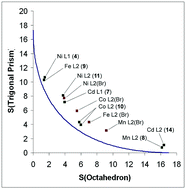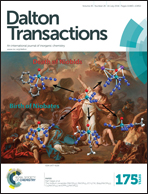Shaping and enforcing coordination spheres: probing the ability of tripodal ligands to favour trigonal prismatic geometry†
Abstract
We report two tripodal frameworks, mono(2,2′-bipyrid-6-yl)bis(2-pyridyl)methanol (L1) and bis(2,2′-bipyrid-6-yl)mono(2-pyridyl)methanol (L2) which have one and two bipyridyl arms, respectively. Both ligands form complexes with the first row transition metals. Both ligands appear to overcome the steric strain involved in twisting the ligand to produce an octahedral complex and the solid state structures in general show more octahedral character than complexes of the related ligand, tris(2,2′-bipyrid-6-yl)methanol (L3). Continuous Shape Mapping (CShM) calculations based on crystallographic data reveal that L1 is incapable of enforcing a trigonal prismatic (TP) co-ordination geometry in the solid state, surprisingly even upon co-ordination to metals with no stereochemical preference such as cadmium (S(TP) = 7.15 and S(Oh) = 3.95). However, ligand L2 clearly maintains an ability to enforce a trigonal prismatic conformation which is demonstrated in the crystal structures of the MnII and CdII complexes (S(TP) = 0.75 and 1.09, respectively). While L3 maintains near-TP configurations in the presence of metal ions with strong octahedral preferences, L2 distorts towards predominantly octahedral co-ordination geometries, increasing in the order CoII < NiII < FeII and no trigonal prismatic structures.



 Please wait while we load your content...
Please wait while we load your content...